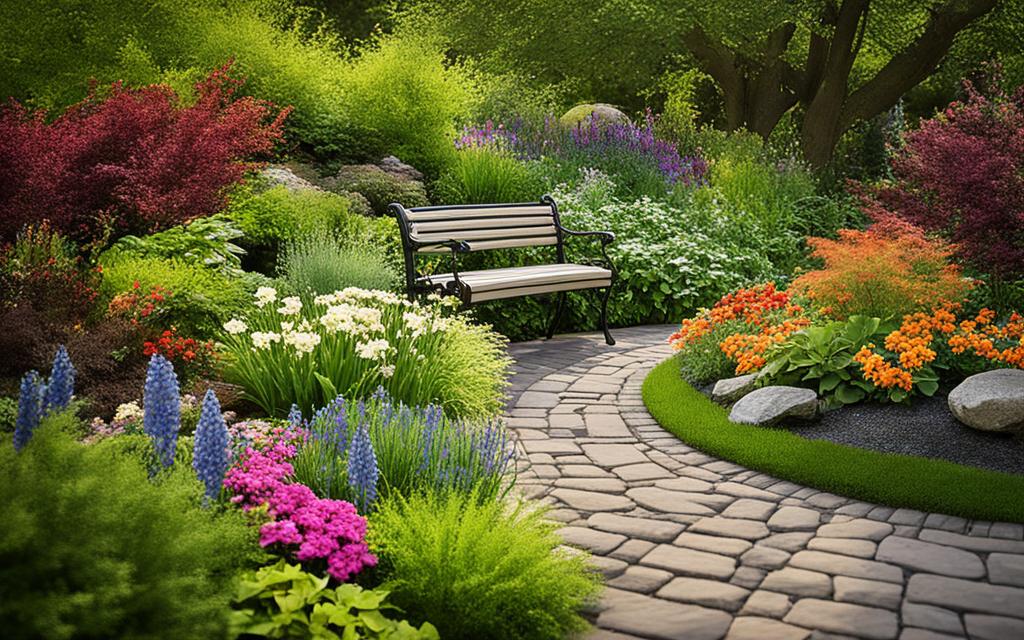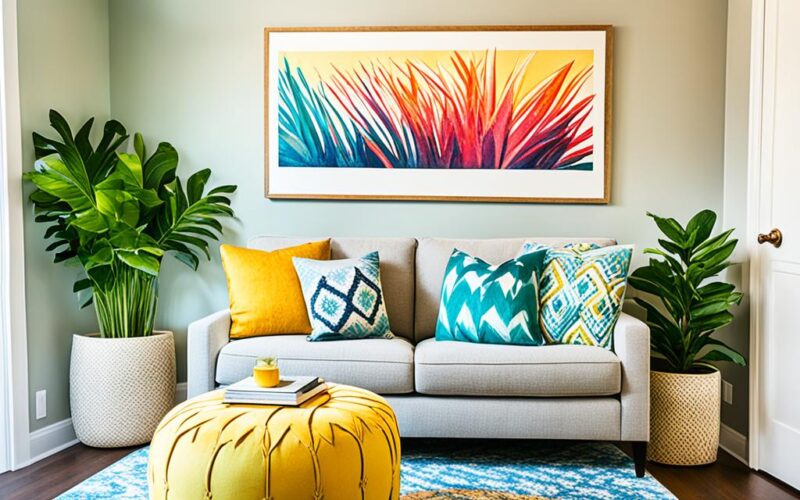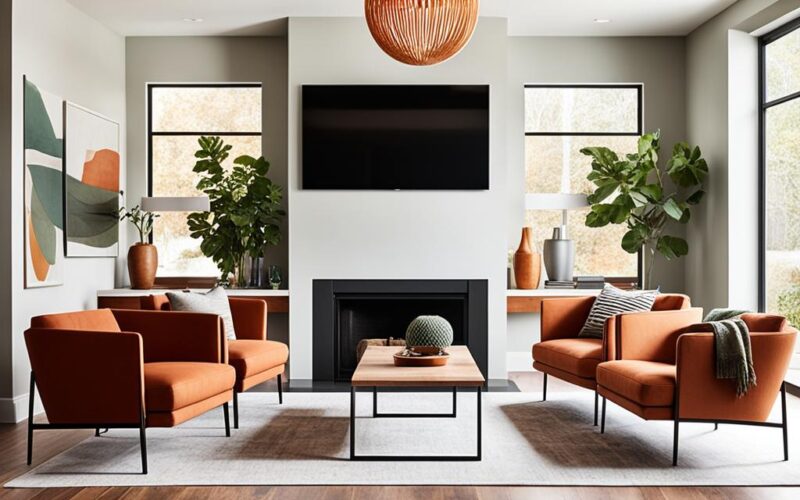Welcome to an exciting journey of outdoor landscaping, where the possibilities are endless, and your living space is waiting to be transformed into a breathtaking oasis. Imagine stepping out into a lush garden surrounded by vibrant colors, soothing sounds, and harmonious design. Outdoor landscaping has the power to elevate your property, enhance your lifestyle, and create a serene retreat right at your doorstep.
Whether you have a sprawling backyard, a cozy balcony, or a small corner longing for attention, outdoor landscaping offers creative solutions to make the most of your space. From gardens and pathways to hardscape features and stylish accessories, every element plays a crucial role in harmonizing aesthetics and functionality.
In the upcoming sections, we will delve into the world of outdoor landscaping, exploring garden design strategies, the art of plant selection, sustainable landscaping practices, and more. Along the way, you’ll discover expert tips on lawn care, transforming your backyard, and creating an inviting outdoor living space that reflects your personal style.
Outdoor landscaping is not just about improving the visual appeal of your property; it is about connecting with nature, finding tranquility, and enjoying the great outdoors. With our guidance, you’ll gain insights into the latest trends, innovative designs, and professional services that will turn your dreams into reality.
So, get ready to unleash your creativity, embrace the beauty of nature, and embark on a transformative outdoor landscaping journey that will change the way you live and experience your space.
Garden Design: Creating a Vision
When it comes to outdoor landscaping, garden design plays a fundamental role in creating a space that is not only visually stunning but also reflects your personal preferences and lifestyle. A well-designed garden serves as the centerpiece of your outdoor oasis, providing a harmonious blend of beauty and functionality.
Whether you have a small backyard or a sprawling estate, a thoughtful garden design can transform your outdoor space into a tranquil retreat or an entertainer’s paradise. It sets the stage for a place where you can relax, unwind, and connect with nature.
But what exactly is garden design, and why is it crucial for your outdoor landscaping endeavors? It encompasses the careful selection and arrangement of plants, trees, shrubs, and other elements to create a cohesive and visually appealing space. Garden design considers various factors, such as sunlight exposure, soil conditions, and the overall aesthetics you wish to achieve.
By planning and visualizing your garden design, you can create a cohesive vision that takes into account not only the landscape’s current state but also its potential for growth and development. A well-designed garden considers the long-term maintenance and sustainability of the space, ensuring that your outdoor landscape remains healthy and vibrant for years to come.
Whether you have a green thumb or are new to gardening, working with a professional garden designer can help you bring your vision to life. Their expertise and knowledge of different plant species, hardscape materials, and design principles can guide you in making informed choices that suit your taste and requirements.
| Benefits of Garden Design | What it entails | Expert Tip |
|---|---|---|
| Enhances the overall aesthetics of your outdoor space | Selecting and arranging plants, trees, and shrubs | Consider the growth patterns of plants to ensure proper spacing and prevent overcrowding. |
| Creates a cohesive and visually appealing landscape | Incorporating hardscape elements, such as pathways and garden structures | Choose hardscape materials that complement the architectural style of your home. |
| Provides a functional and practical outdoor environment | Considering the layout and purpose of different areas within the garden | Divide your garden into zones based on activities, such as dining, relaxation, and gardening. |
| Maximizes the use of space and optimizes natural resources | Utilizing sustainable practices, rainwater harvesting, and efficient irrigation systems | Choose native and drought-tolerant plant species to minimize water usage. |
Garden design is the blueprint that guides the transformation of your outdoor space into a harmonious and visually captivating landscape. It ensures that every element, from the choice of plants to the arrangement of hardscape features, works together seamlessly to create a cohesive and welcoming environment.
See your outdoor space flourish with a carefully crafted garden design that reflects your unique style and amplifies the beauty of nature. In the next section, we will delve into the intricacies of landscape architecture and its role in outdoor landscaping.
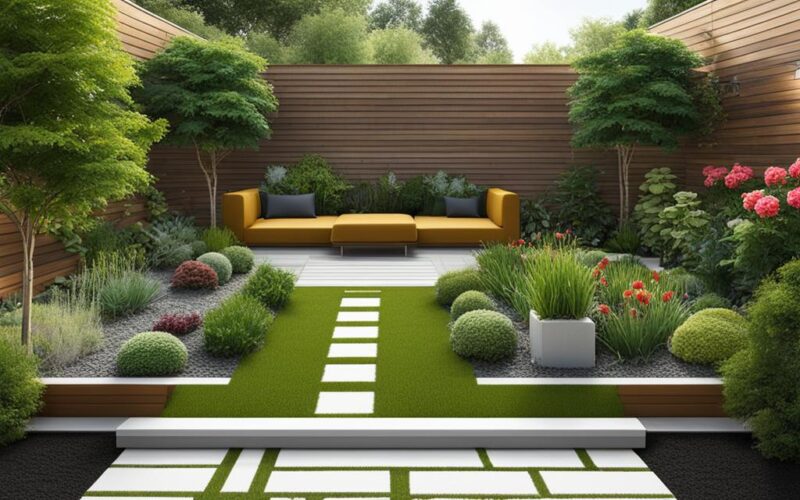
How to Get Started with Garden Design
Here are some steps to begin your garden design journey:
- Assess your space: Take note of the size, topography, and existing landscaping features in your outdoor space.
- Determine your needs and preferences: Consider how you want to use your garden and what design elements resonate with your style.
- Research and gather inspiration: Look for design ideas, explore different plant options, and collect images of gardens that inspire you.
- Consult with a professional: Engage a garden designer who can provide expert guidance and translate your vision into a cohesive design plan.
- Create a design plan: Collaborate with your designer to develop a detailed plan that includes plant selection, hardscape elements, and a layout for your garden.
- Implement and maintain: Work with your designer or undertake the installation yourself, following the design plan. Regularly care for your garden to ensure its longevity and vibrancy.
Landscape Architecture: Blending Form and Function
When it comes to outdoor landscaping, landscape architecture plays a crucial role in creating a visually stunning and functional environment. By seamlessly integrating form and function, landscape architects design outdoor spaces that not only enhance the beauty of your property but also elevate your overall living experience. Let’s dive deeper into the principles of landscape architecture and how it can transform your outdoor space.
The Principles of Landscape Architecture
Landscape architecture is a multidisciplinary practice that combines art, science, and environmental stewardship to design outdoor areas that are aesthetically pleasing, sustainable, and practical. These are some of the key principles that landscape architects follow:
- Site analysis and planning: Landscape architects thoroughly assess the site’s characteristics, including topography, soil conditions, climate, and existing elements, to create a comprehensive plan for the outdoor space.
- Functional design: Landscape architects consider the intended uses of the outdoor area and design it accordingly. They carefully plan elements such as pathways, seating areas, and recreational spaces to ensure optimal functionality.
- Aesthetic harmony: Landscape architects have a deep understanding of elements like color, texture, scale, and proportion. They skillfully use these design principles to create a harmonious and visually pleasing outdoor environment.
- Sustainability and environmental stewardship: Landscape architects prioritize sustainable design practices that minimize negative impacts on the environment. They incorporate strategies like water conservation, use of native plants, and eco-friendly materials to promote a healthy and eco-conscious outdoor landscape.
The Benefits of Landscape Architecture
Investing in landscape architecture offers numerous benefits for homeowners:
- Enhanced property value: A thoughtfully designed outdoor space adds significant value to your property, increasing its curb appeal and marketability.
- Improved quality of life: A well-designed outdoor environment provides a place for relaxation, recreation, and connection with nature, resulting in a higher quality of life for you and your family.
- Increased functionality: Landscape architecture ensures that your outdoor space is designed to fulfill your specific needs and activities, whether it’s hosting gatherings, playing sports, or simply enjoying solitude.
- Health and well-being: Connecting with nature has numerous health benefits, including stress reduction, improved mental well-being, and increased physical activity.
- Sustainability: By incorporating sustainable design practices, landscape architecture promotes responsible use of resources, reduces water consumption, and preserves ecological integrity.
By collaborating with a skilled landscape architect, you can create a captivating outdoor landscape that perfectly blends form and function, bringing your vision to life while enriching your daily living experience.
Backyard Transformation: Maximizing Your Outdoor Living Space
When it comes to creating an inviting and functional outdoor living space, a backyard transformation is key. By utilizing outdoor landscaping techniques, you can unlock the full potential of your backyard, turning it into a haven for relaxation and entertainment. Whether you have a small urban patio or a sprawling suburban yard, there are numerous ways to maximize your outdoor space.
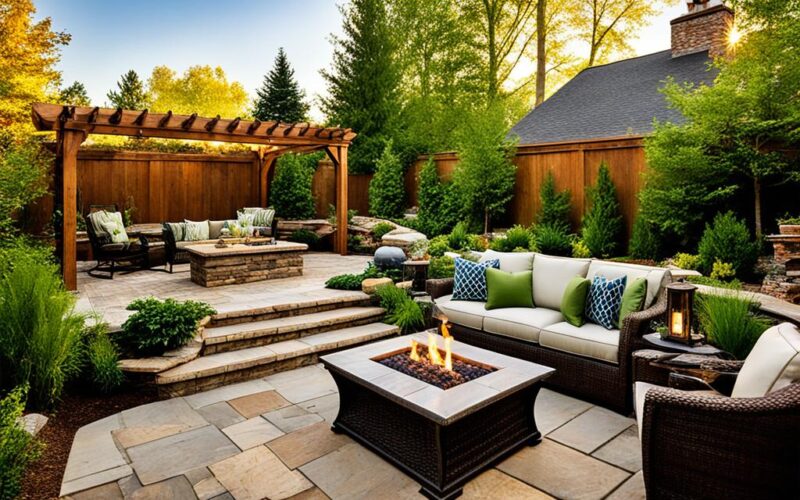
One of the first steps in your backyard transformation is to carefully plan the layout and design of your outdoor space. Take into consideration your specific needs and preferences, as well as the natural elements of your surroundings. By blending form and function, you can create a harmonious outdoor landscape that seamlessly integrates with your home.
Creating Zones for Different Activities
To make the most of your outdoor living space, consider dividing it into different zones to accommodate various activities. This allows for seamless transitions between areas and maximizes the usability of your backyard. Here are a few ideas to inspire your backyard zoning:
- Create a cozy seating area for relaxation and conversation.
- Set up a dining space for al fresco meals with family and friends.
- Designate an open area for outdoor games and activities.
- Add a fire pit or outdoor fireplace for warmth and ambiance.
- Incorporate a garden or green space for tranquility and beauty.
By creating these distinct zones, you can enjoy a versatile outdoor living space that caters to your specific needs and preferences.
Integrating Vertical Elements
In addition to horizontal spaces, don’t forget to utilize the vertical elements of your backyard. By incorporating features such as trellises, pergolas, or vertical gardens, you can add depth and visual interest to your outdoor landscape. These elements not only enhance the aesthetics but also provide privacy and shade, transforming your backyard into a secluded retreat.
Strategic Planting and Lighting
Strategic planting and lighting are crucial in maximizing the beauty and functionality of your outdoor living space. Choose plants that are well-suited to your climate and provide year-round visual interest. Incorporate layers of lighting, including task lighting for functional areas and ambient lighting for creating a welcoming atmosphere. These elements not only add personality but also enhance the safety and enjoyment of your backyard.
Accessorizing for Comfort and Style
Finally, don’t overlook the power of accessories in transforming your outdoor space. From comfortable furniture and weather-resistant cushions to stylish rugs and outdoor artwork, the right accessories can elevate the comfort and style of your backyard. Invest in quality, durable pieces that can withstand the elements and enhance your overall outdoor experience.
With a well-planned backyard transformation, you can create an outdoor living space that seamlessly extends the comfort and beauty of your home. By utilizing outdoor landscaping techniques, you can maximize your backyard’s potential and enjoy countless hours of outdoor relaxation and entertainment.
Hardscape Design: Adding Structure and Style
When it comes to outdoor landscaping, hardscape design plays a crucial role in transforming your space into a visually appealing and functional oasis. By incorporating various hardscape elements, such as pathways, patios, and retaining walls, you can create a landscape that not only complements the natural beauty of your surroundings but also adds structure and style to your outdoor environment.
One of the key benefits of hardscape design is its ability to define different areas within your outdoor space, creating distinct zones for various activities. For example, a beautifully designed patio can serve as an inviting gathering space for outdoor dining and entertainment, while well-placed pathways can guide visitors through your garden and highlight its unique features.
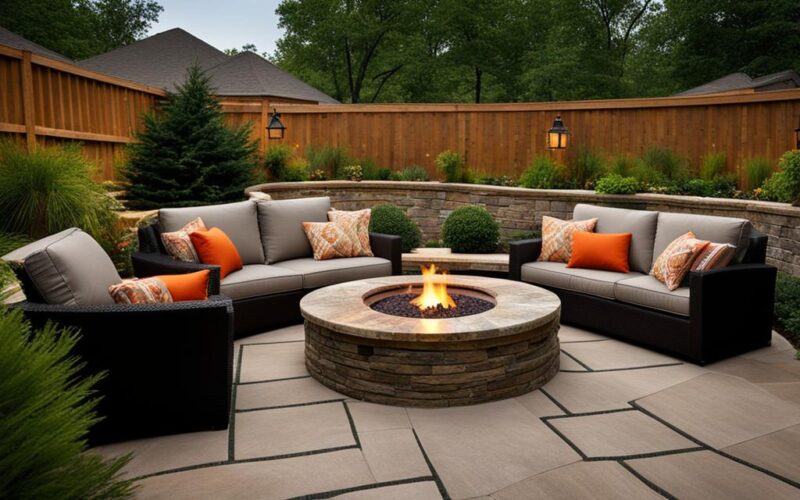
In addition to providing structure, hardscape elements also enhance the functionality of your outdoor space. Retaining walls, for instance, can be used to create terraced levels, allowing for better water drainage and preventing soil erosion. Patios and decks offer comfortable areas for seating and lounging, while walkways provide safe and convenient access between different parts of your landscape.
Materials and Design Choices
When it comes to hardscape design, the materials you choose play a significant role in the overall aesthetic and durability of your outdoor space. From natural stone to concrete pavers, there are a variety of options available to suit your design preferences and budget.
The design choices you make also contribute to the style and atmosphere of your outdoor area. Whether you prefer a modern and minimalist look or a more rustic and traditional feel, hardscape design allows you to express your personal taste and create a space that reflects your unique lifestyle.
Maintaining Your Hardscape
Proper maintenance is key to preserving the beauty and functionality of your hardscape design. Regular cleaning and sealing of surfaces, as well as addressing any necessary repairs, will ensure that your pathways, patios, and retaining walls remain in optimal condition for years to come.
By incorporating hardscape design into your outdoor landscaping, you can elevate the visual appeal and functionality of your space. From creating defined areas to choosing the right materials and design choices, hardscape elements add structure and style while enhancing your overall outdoor experience.
Plant Selection: Bringing Life and Color to Your Landscape
One of the key elements in creating a stunning outdoor landscape is the careful selection of plants. The right plants can bring life, color, and texture to your garden, turning it into a vibrant and inviting space. But how do you choose the perfect plants for your outdoor landscaping project?
When selecting plants, it’s essential to consider various factors such as your climate, soil type, sunlight exposure, and maintenance requirements. By understanding these factors, you can create a thriving and low-maintenance landscape that enhances the beauty of your property.
Climate Considerations
One of the most critical aspects of plant selection is choosing species that thrive in your specific climate. Different plants have different temperature, humidity, and water requirements. By selecting plants suited to your climate, you can ensure their survival and minimize the need for excessive care and maintenance.
Research the hardiness zone of your area to determine the types of plants that are best suited for your location. Consider factors such as the average annual temperature range, frost dates, and rainfall patterns. By selecting plants that are well-adapted to your climate, you can create a thriving and resilient landscape.
Year-Round Visual Interest
Creating a visually appealing landscape starts with choosing plants that offer interest and beauty throughout the year. While flowers are often the first choice for adding color, consider incorporating plants with diverse foliage, attractive bark, or interesting shapes.
For example, evergreen trees and shrubs maintain their foliage year-round, providing a constant source of greenery and structure. Perennials and shrubs that bloom in different seasons can offer a dynamic and changing display of colors throughout the year. By selecting plants that offer visual interest no matter the season, you can ensure a beautiful landscape landscape year-round.
Sustainability and Low-Maintenance
Incorporating sustainable and low-maintenance plants into your landscape design can help reduce the need for excessive watering, fertilizers, and pesticides. Native plants are often well-adapted to local conditions, requiring minimal care and resources.
Consider selecting native plants that are drought-tolerant, disease-resistant, and attract local wildlife. Not only will these plants thrive with minimal intervention, but they will also contribute to the ecological balance of your garden, attracting beneficial insects and birds while supporting local ecosystems.
Additionally, incorporating a variety of plant species can enhance the biodiversity of your landscape, reducing the risk of plant diseases and pest infestations while creating a visually diverse and interesting space.
| Benefits of Thoughtful Plant Selection | How to Achieve It |
|---|---|
| Thrive in your climate | Research hardiness zones and choose plants adapted to your area’s temperature and rainfall patterns. |
| Offer year-round visual interest | Combine plants with varied foliage colors and textures, as well as staggered bloom times. |
| Contribute to sustainability and low-maintenance | Select native plants, drought-tolerant species, and those attractive to local wildlife. |
By carefully selecting plants that thrive in your climate, offer year-round visual interest, and promote sustainability, you can create a breathtaking outdoor landscape that requires minimal maintenance and brings joy throughout the seasons.
Next, we’ll explore the benefits of sustainable landscaping practices and how they can further enhance your outdoor space.
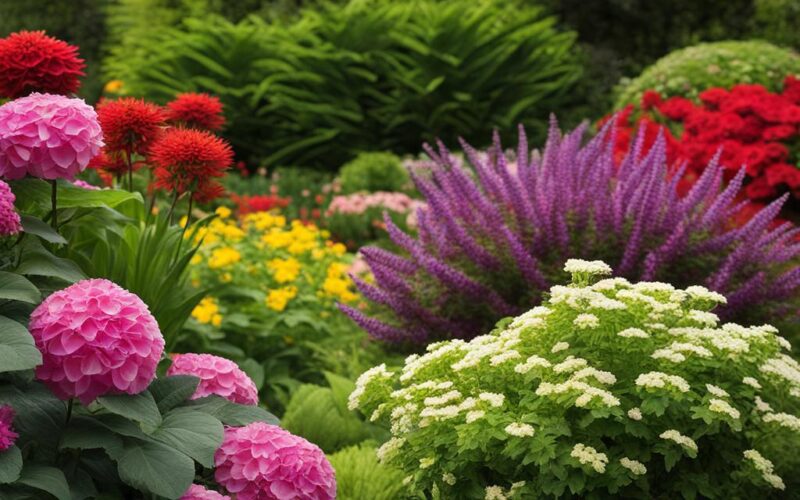
Sustainable Landscaping: Nurturing the Environment
In today’s world, where environmental conservation is more important than ever, sustainable landscaping practices have gained significant momentum. By implementing eco-friendly strategies, such as water conservation, the use of native plants, and responsible management of fertilizers and pesticides, you can create an outdoor space that not only enhances the beauty of your property but also nurtures the environment.
Benefits of Sustainable Landscaping
Choosing sustainable landscaping practices offers a multitude of benefits for both you and the environment:
- Water Conservation: Sustainable landscaping emphasizes efficient water usage through techniques like drip irrigation and the incorporation of drought-tolerant plants. This not only helps conserve this valuable resource but also reduces water bills and minimizes the impact on local water supplies.
- Beneficial Wildlife Habitat: By planting native plants and creating natural habitats, sustainable landscaping attracts and supports local wildlife such as birds, butterflies, and beneficial insects. This promotes biodiversity and contributes to the overall health of the ecosystem.
- Reduced Chemical Usage: Implementing sustainable practices minimizes the need for harmful fertilizers and pesticides that can contaminate soil and water sources. By using organic alternatives and integrated pest management techniques, you can create a healthier environment for both humans and wildlife.
- Improved Soil Health: Sustainable landscaping practices focus on enhancing soil quality through practices like composting and mulching. Healthy soil promotes better plant growth, reduces erosion, and improves water infiltration and retention.
- Energy Efficiency: Thoughtful placement of trees and shrubs in your landscape provides natural shade and reduces the energy consumption required for cooling your home during hot summers. In colder climates, strategic planting can also act as windbreaks, reducing heat loss and lowering heating costs.
When it comes to sustainable landscaping, every small step counts. Whether you’re starting from scratch or making adjustments to an existing landscape, incorporating these practices can make a significant impact on the environment and your surroundings.
Take a look at the following table for a summary of the benefits of sustainable landscaping:
| Benefits of Sustainable Landscaping |
|---|
| Water Conservation |
| Beneficial Wildlife Habitat |
| Reduced Chemical Usage |
| Improved Soil Health |
| Energy Efficiency |
Sustainable landscaping not only benefits the environment but also adds value to your property. It creates a harmonious outdoor space that aligns with your values and promotes a healthier way of living. By embracing sustainable practices, you can make a positive impact on the environment while enjoying a beautiful outdoor sanctuary.
Lawn Care: Maintaining a Lush and Healthy Lawn
Keeping your lawn in pristine condition is essential for creating a vibrant and inviting outdoor space. Proper lawn care goes beyond simply mowing the grass – it involves a comprehensive approach that includes watering, fertilizing, and weed control. By following these essential tips and techniques, you can ensure that your lawn remains healthy and lush throughout the year, adding beauty to your outdoor landscaping.
Mowing: A Key Component of Lawn Care
Mowing is an important aspect of maintaining a healthy lawn. By trimming the grass to the appropriate height, you promote healthy growth and prevent weed infestation. Follow these guidelines for effective mowing:
- Mow regularly, ensuring you never remove more than one-third of the grass height at a time.
- Adjust the mower height based on the season and grass type. Different grass varieties have specific height requirements for optimal growth.
- Keep your mower blades sharp to achieve clean cuts and minimize stress on the grass.
- Vary the mowing pattern to prevent soil compaction and encourage upright growth.
Watering: Finding the Right Balance
Proper watering is crucial for a lush and healthy lawn. However, finding the right balance can be challenging. Follow these watering tips to help your lawn thrive:
- Water deeply but infrequently to encourage deep root growth. Shallow, frequent watering can lead to weak and shallow root systems.
- Water early in the morning to reduce evaporation and allow the grass to dry before evening, minimizing the risk of disease.
- Use a rain gauge or moisture probe to determine when irrigation is necessary. Aim for about 1-1.5 inches of water per week, including rainfall.
- Adjust watering frequency and duration based on weather conditions, allowing for natural precipitation.
Fertilizing: Nourishing Your Lawn
Fertilization is essential for providing your lawn with the nutrients it needs to thrive. Consider the following fertilizing tips:
- Test your soil to determine its nutrient needs. This will help you choose the appropriate fertilizer and application schedule.
- Apply fertilizer according to the manufacturer’s instructions, considering factors such as grass type, climate, and time of year.
- Avoid over-fertilization, as it can lead to excessive growth, thatch buildup, and environmental pollution.
- Consider using organic fertilizers, which provide slow-release nutrients and improve soil health over time.
Weed Control: Keeping Your Lawn Weed-Free
Weeds can detract from the beauty of your lawn and compete with grass for essential resources. Implement these weed control strategies to maintain a pristine lawn:
- Maintain a healthy, dense lawn through proper mowing, watering, and fertilizing. A well-established lawn can naturally suppress weed growth.
- Identify and target weeds early on. Regularly inspect your lawn and manually remove weeds before they have a chance to spread.
- Consider using herbicides only as a last resort. If necessary, choose selective herbicides that target specific weeds without harming desirable grass species.
- Practice good lawn maintenance habits, such as proper irrigation and regular dethatching, to minimize weed invasion.
To achieve a lush and healthy lawn, it’s crucial to incorporate these lawn care practices into your outdoor landscaping routine. With proper mowing, watering, fertilizing, and weed control, you can create a stunning outdoor environment that enhances the overall appeal of your property.
Enhancing Outdoor Living: Furniture, Lighting, and Accessories
Creating an inviting and comfortable outdoor living space is essential for enjoying the beauty of your outdoor landscaping. Choosing the right furniture, lighting, and accessories can transform your outdoor area into a haven where you can relax, entertain, and make lasting memories with family and friends.
Functional and Stylish Furniture
Your outdoor furniture should be both functional and stylish, providing comfort while complementing the overall design of your outdoor living space. Consider furniture made from durable materials that can withstand the elements, such as wrought iron, teak, or weather-resistant wicker. Opt for comfortable seating options, like lounge chairs, sofas, or outdoor sectionals, and include a dining set for al fresco meals. Don’t forget to add cushions, pillows, and throws for added coziness and visual appeal.
Atmospheric Lighting
Outdoor lighting sets the mood and creates a warm and inviting ambiance in your outdoor living space. Choose a combination of task lighting, accent lighting, and ambient lighting to achieve a well-balanced and functional lighting scheme. Consider installing wall sconces, string lights, or lanterns to illuminate pathways, seating areas, and dining spaces. Enhance the beauty of your landscape with strategically placed spotlights to highlight trees, shrubs, and architectural features.
Statement Accessories
Add character and style to your outdoor living space with carefully chosen accessories. From colorful outdoor rugs and vibrant throw pillows to decorative planters and artwork, accessories can add personality and make your space feel like an extension of your indoor living area. Consider incorporating elements such as a fire pit or a water feature for added visual interest and relaxation. Don’t forget about practical accessories like outdoor storage solutions to keep your space organized.
By paying attention to furniture, lighting, and accessories, you can elevate your outdoor living space to the next level, creating a harmonious and inviting atmosphere that extends the comforts of your home into the great outdoors.
| Benefits of Enhancing Outdoor Living Space | Examples |
|---|---|
| Increased relaxation and enjoyment of outdoor areas | Outdoor seating area with a comfortable sofa and lounge chairs |
| Opportunity for entertaining guests and hosting gatherings | Outdoor dining set with ample seating for family and friends |
| Extended living space that adds value to your property | Outdoor kitchen with a grill, countertop, and seating area |
| Personalization and expression of your unique style | Decorative outdoor rugs, throw pillows, and artwork |
| Seamless integration of indoor and outdoor living areas | Cozy outdoor seating area with a fire pit |
Bringing it All Together: Expert Outdoor Landscaping Services
When it comes to transforming your outdoor space into a beautiful and functional oasis, hiring professional outdoor landscaping services is a wise investment. These experts have the knowledge, skills, and experience to bring your vision to life, ensuring that every aspect of your outdoor landscaping, from the initial design to the final installation and ongoing maintenance, is executed with precision and attention to detail.
With their expertise in landscape architecture and garden design, these professionals can create a cohesive and visually stunning outdoor environment that complements your property’s style and enhances its value. They have a deep understanding of how to blend form and function, integrating elements such as hardscape design, plant selection, and sustainable landscaping practices to create a harmonious and inviting outdoor space.
By enlisting the help of outdoor landscaping services, you can save time and effort while achieving outstanding results. These professionals have access to a wide range of resources, materials, and plants, ensuring that your outdoor landscape is not only beautiful but also durable and long-lasting. They take care of all the intricate details, leaving you free to enjoy your outdoor living space to the fullest.

